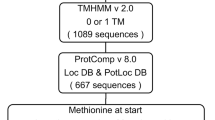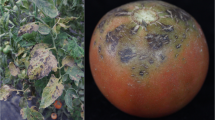Abstract
Secreted proteins (secretomes) play crucial roles during bacterial pathogenesis in both plant and human hosts. The identification and characterization of secretomes in the two plant pathogens Burkholderia glumae BGR1 and B. gladioli BSR3, which cause diseases in rice such as seedling blight, panicle blight, and grain rot, are important steps to not only understand the disease-causing mechanisms but also find remedies for the diseases. Here, we identified two datasets of secretomes in B. glumae BGR1 and B. gladioli BSR3, which consist of 118 and 111 proteins, respectively, using mass spectrometry approach and literature curation. Next, we characterized the functional properties, potential secretion pathways and sequence information properties of secretomes of two plant pathogens in a comparative analysis by various computational approaches. The ratio of potential non-classically secreted proteins (NCSPs) to classically secreted proteins (CSPs) in B. glumae BGR1 was greater than that in B. gladioli BSR3. For CSPs, the putative hydrophobic regions (PHRs) which are essential for secretion process of CSPs were screened in detail at their N-terminal sequences using hidden Markov model (HMM)–based method. Total 31 pairs of homologous proteins in two bacterial secretomes were indicated based on the global alignment (identity ≥ 70%). Our results may facilitate the understanding of the species-specific features of secretomes in two plant pathogenic Burkholderia species.
Similar content being viewed by others
References
Alfano, J.R. and Collmer, A. 2004. Type III secretion system effector proteins: double agents in bacterial disease and plant defense. Annu. Rev. Phytopathol. 42, 385–414.
Arnold, R., Brandmaier, S., Kleine, F., Tischler, P., Heinz, E., Behrens, S., Niinikoski, A., Mewes, H.W., Horn, M., and Rattei, T. 2009. Sequence-based prediction of type III secreted proteins. PLoS Pathog. 5, e1000376.
Baum, L.E., Petrie, T., Soules, G., and Weiss, N. 1970. A maximization technique occurring in the statistical analysis of probabilistic functions of Markov chains. Ann. Math. Stat. 41, 164–171.
Bendtsen, J.D., Jensen, L.J., Blom, N., Von Heijne, G., and Brunak, S. 2004. Feature-based prediction of non-classical and leader less protein secretion. Protein Eng. Des. Sel. 17, 349–356.
Bendtsen, J.D., Kiemer, L., Fausbøll, A., and Brunak, S. 2005a. Nonclassical protein secretion in bacteria. BMC Microbiol. 5, 58.
Bendtsen, J.D., Nielsen, H., Widdick, D., Palmer, T., and Brunak, S. 2005b. Prediction of twin-arginine signal peptides. BMC Bioinformatics 6, 167.
Brocchieri, L. and Karlin, S. 2005. Protein length in eukaryotic and prokaryotic proteomes. Nucleic Acids Res. 33, 3390–3400.
Büttner, D. and He, S.Y. 2009. Type III protein secretion in plant pathogenic bacteria. Plant Physiol. 150, 1656–1664.
Collmer, A. 1998. Determinants of pathogenicity and avirulence in plant pathogenic bacteria. Curr. Opin. Plant Biol. 1, 329–335.
Compant, S., Nowak, J., Coenye, T., Clement, C., and Ait Barka, E. 2008. Diversity and occurrence of Burkholderia spp. in the natural environment. FEMS Microbiol. Rev. 32, 607–626.
Dalbey, R.E. and Kuhn, A. 2012. Protein traffic in Gram-negative bacteria–how exported and secreted proteins find their way. FEMS Microbiol. Rev. 36, 1023–1045.
Dean, P. 2011. Functional domains and motifs of bacterial type III effector proteins and their roles in infection. FEMS Microbiol. Rev. 35, 1100–1125.
Desvaux, M., Hebraud, M., Talon, R., and Henderson, I.R. 2009. Secretion and subcellular localizations of bacterial proteins: a semantic awareness issue. Trends Microbiol. 17, 139–145.
Estrada-de los Santos, P., Vinuesa, P., Martinez-Aguilar, L., Hirsch, A.M., and Caballero-Mellado, J. 2013. Phylogenetic analysis of Burkholderia species by multilocus sequence analysis. Curr. Microbiol. 67, 51–60.
Fang, H. and Gough, J. 2013. DcGO: database of domain-centric ontologies on functions, phenotypes, diseases and more. Nucleic Acids Res. 41, 17.
Feng, F. and Zhou, J.M. 2012. Plant-bacterial pathogen interactions mediated by type III effectors. Curr. Opin. Plant Biol. 15, 469–476.
Filloux, A., Hachani, A., and Bleves, S. 2008. The bacterial type VI secretion machine: yet another player for protein transport across membranes. Microbiology 154, 1570–1583.
Fory, P., Triplett, L., Ballen, C., Abello, J., Duitama, J., Aricapa, M., Prado, G., Correa, F., Hamilton, J., and Leach, J. 2014. Comparative analysis of two emerging rice seed bacterial pathogens. Phytopathology 104, 436–444.
Fredrickson, E.K., Rosenbaum, J.C., Locke, M.N., Milac, T.I., and Gardner, R.G. 2011. Exposed hydrophobicity is a key determinant of nuclear quality control degradation. Mol. Biol. Cell 22, 2384–2395.
Goo, E., Kang, Y., Kim, H., and Hwang, I. 2010. Proteomic analysis of quorum sensing-dependent proteins in Burkholderia glumae. J. Proteome Res. 9, 3184–3199.
Ham, J.H., Melanson, R.A., and Rush, M.C. 2011. Burkholderia glumae: next major pathogen of rice? Mol. Plant Pathol. 12, 329–339.
Hegde, R.S. and Bernstein, H.D. 2006. The surprising complexity of signal sequences. Trends Biochem. Sci. 31, 563–571.
Izard, J.W. and Kendall, D.A. 1994. Signal peptides: exquisitely designed transport promoters. Mol. Microbiol. 13, 765–773.
Jeong, Y., Kim, J., Kim, S., Kang, Y., Nagamatsu, T., and Hwang, I. 2003. Toxoflavin produced by Burkholderia glumae causing rice grain rot is responsible for inducing bacterial wilt in many field crops. Plant Disease 87, 890–895.
Kampenusa, I. and Zikmanis, P. 2010. Distinguishable codon usage and amino acid composition patterns among substrates of leaderless secretory pathways from proteobacteria. Appl. Microbiol. Biotechnol. 86, 285–293.
Kang, Y., Kim, J., Kim, S., Kim, H., Lim, J.Y., Kim, M., Kwak, J., Moon, J.S., and Hwang, I. 2008. Proteomic analysis of the proteins regulated by HrpB from the plant pathogenic bacterium Burkholderia glumae. Proteomics 8, 106–121.
Kim, J.H., An, H.J., Garrido, D., German, J.B., Lebrilla, C.B., and Mills, D.A. 2013. Proteomic analysis of Bifidobacterium longum subsp. infantis reveals the metabolic insight on consumption of prebiotics and host glycans. PLoS One 8, e57535.
Kostakioti, M., Newman, C.L., Thanassi, D.G., and Stathopoulos, C. 2005. Mechanisms of protein export across the bacterial outer membrane. J. Bacteriol. 187, 4306–4314.
Kyte, J. and Doolittle, R.F. 1982. A simple method for displaying the hydropathic character of a protein. J. Mol. Biol. 157, 105–132.
Lewis, C., Baro, M.F., Marques, M., Grüner, M., Alonso, A., and Bravo, I.G. 2008. The first hydrophobic region of the HPV16 E5 protein determines protein cellular location and facilitates anchorage-independent growth. Virol. J. 5, 30.
Lipman, D.J., Souvorov, A., Koonin, E.V., Panchenko, A.R., and Tatusova, T.A. 2002. The relationship of protein conservation and sequence length. BMC Evol. Biol. 2, 1–10.
Martoglio, B. and Dobberstein, B. 1998. Signal sequences: more than just greasy peptides. Trends Cell Biol. 8, 410–415.
Nagaraj, R. 1987. Role of the hydrophobic region of signal sequences in the targeting of proteins to membranes and translocation across the hydrophobic membrane barrier. Proc. Indian Acad. Sci. (Chem. Sci.) 98, 479–485.
Nandakumar, R., Shahjahan, A., Yuan, X., Dickstein, E., Groth, D., Clark, C., Cartwright, R., and Rush, M. 2009. Burkholderia glumae and B. gladioli cause bacterial panicle blight in rice in the southern United States. Plant Disease 93, 896–905.
Needleman, S.B. and Wunsch, C.D. 1970. A general method applicable to the search for similarities in the amino acid sequence of two proteins. J. Mol. Biol. 48, 443–453.
Nickel, W. 2003. The mystery of nonclassical protein secretion. Eur. J. Biochem. 270, 2109–2119.
Nielsen, H. and Krogh, A. 1998. Prediction of signal peptides and signal anchors by a hidden Markov model. Proc. Int. Conf. Intell. Syst. Mol. Biol. 6, 122–130.
Petersen, T.N., Brunak, S., von Heijne, G., and Nielsen, H. 2011. SignalP 4.0: discriminating signal peptides from transmembrane regions. Nat. Meth. 8, 785–786.
Preston, G.M., Studholme, D.J., and Caldelari, I. 2005. Profiling the secretomes of plant pathogenic Proteobacteria. FEMS Microbiol. Rev. 29, 331–360.
Pundhir, S. and Kumar, A. 2011. SSPred: A prediction server based on SVM for the identification and classification of proteins involved in bacterial secretion systems. Bioinformation 6, 380–382.
Rabiner, L. 1989. A tutorial on hidden Markov models and selected applications in speech recognition. Proceed. IEEE 77, 257–286.
Russell, A.B., Peterson, S.B., and Mougous, J.D. 2014. Type VI secretion system effectors: poisons with a purpose. Nat. Rev. Microbiol. 12, 137–148.
Sawana, A., Adeolu, M., and Gupta, R.S. 2014. Molecular signatures and phylogenomic analysis of the genus Burkholderia: Proposal for division of this genus into the emended genus Burkholderia containing pathogenic organisms and a new genus Paraburkholderia gen. nov. harboring environmental species. Front. Genet. 5, 429.
Schell, M.A., Ulrich, R.L., Ribot, W.J., Brueggemann, E.E., Hines, H.B., Chen, D., Lipscomb, L., Kim, H.S., Mrazek, J., Nierman, W.C., et al. 2007. Type VI secretion is a major virulence determinant in Burkholderia mallei. Mol. Microbiol. 64, 1466–1485.
Suarez-Moreno, Z.R., Caballero-Mellado, J., Coutinho, B.G., Mendonca-Previato, L., James, E.K., and Venturi, V. 2012. Common features of environmental and potentially beneficial plant-associated Burkholderia. Microb. Ecol. 63, 249–266.
Tan, T., Frenkel, D., Gupta, V., and Deem, M.W. 2005. Length, protein–protein interactions, and complexity. Physica A 350, 52–62.
Tatarinova, T., Salih, B., Dien Bard, J., Cohen, I., and Bolshoy, A. 2015. Lengths of orthologous prokaryotic proteins are affected by evolutionary factors. BioMed Res. Int. 2015, 11.
Tseng, T.T., Tyler, B.M., and Setubal, J.C. 2009. Protein secretion systems in bacterial-host associations, and their description in the Gene Ontology. BMC Microbiol. 9, 1–9.
Ura, H., Furuya, N., Iiyama, K., Hidaka, M., Tsuchiya, K., and Matsuyama, N. 2006. Burkholderia gladioli associated with symptoms of bacterial grain rot and leaf-sheath browning of rice plants. J. Gen. Plant Pathol. 72, 98–103.
Viterbi, A.J. 1967. Error bounds for convolutional codes and an asymptotically optimum decoding algorithm. IEEE Trans. Inf. Theory 13, 260–269.
von Heijne, G. 1992. Membrane protein structure prediction. Hydrophobicity analysis and the positive-inside rule. J. Mol. Biol. 225, 487–494.
Zehmer, J.K., Bartz, R., Liu, P., and Anderson, R.G. 2008. Identification of a novel N-terminal hydrophobic sequence that targets proteins to lipid droplets. J. Cell Sci. 121, 1852–1860.
Zhang, J. 2000. Protein-length distributions for the three domains of life. Trends Genet. 16, 107–109.
Author information
Authors and Affiliations
Corresponding authors
Additional information
Supplemental material for this article may be found at http://www.springerlink.com/content/120956.
Electronic supplementary material
Rights and permissions
About this article
Cite this article
Nguyen, T.T., Chon, TS., Kim, J. et al. Comparative and bioinformatics analyses of pathogenic bacterial secretomes identified by mass spectrometry in Burkholderia species. J Microbiol. 55, 568–582 (2017). https://doi.org/10.1007/s12275-017-7085-0
Received:
Revised:
Accepted:
Published:
Issue Date:
DOI: https://doi.org/10.1007/s12275-017-7085-0




